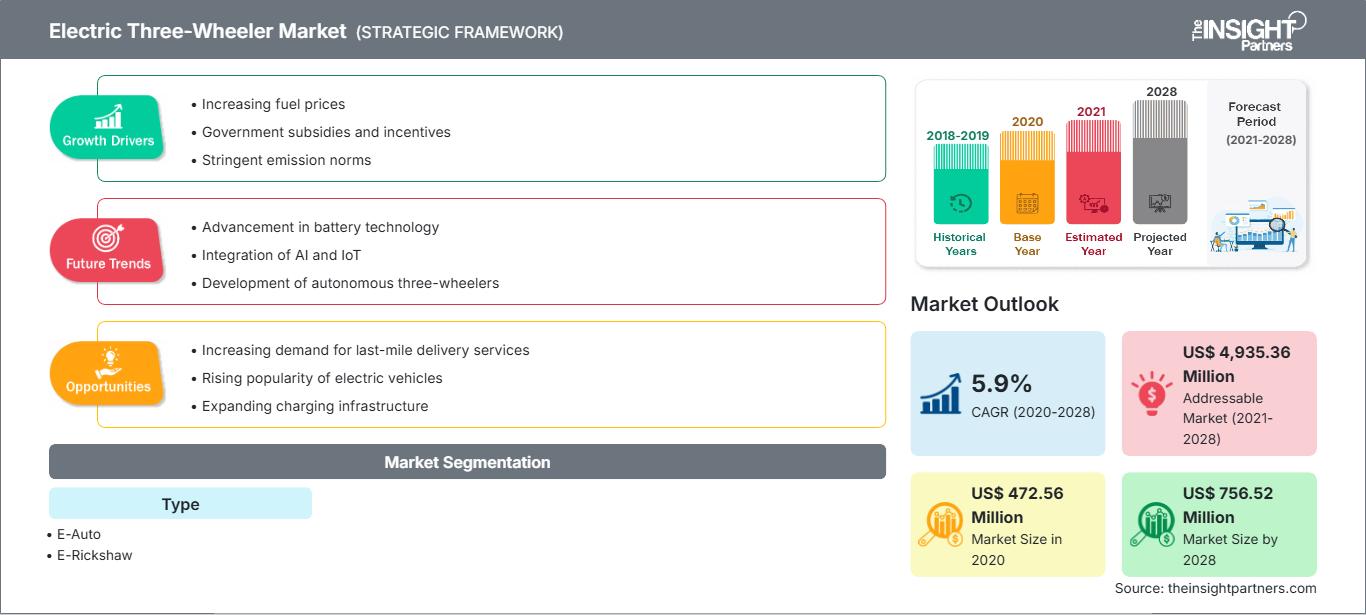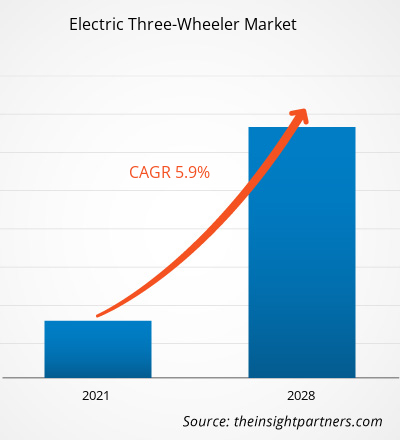Der Markt für elektrische Dreiräder wurde im Jahr 2020 auf 472,56 Millionen US-Dollar geschätzt und soll bis 2028 756,52 Millionen US-Dollar erreichen; von 2021 bis 2028 wird ein durchschnittliches jährliches Wachstum von 5,9 % erwartet.
Elektrische Dreiräder werden häufig verwendet, um Passagiere an ihr gewünschtes Ziel zu bringen und um Güter zu transportieren. Diese Dreiräder werden von Elektromotoren angetrieben, die von wiederaufladbaren Batterien gespeist werden. Die Batterien können an einer Ladestation oder einer anderen entsprechenden Ladestation aufgeladen werden. In vielen Ländern mit niedrigem und mittlerem Einkommen weltweit sind Dreiräder häufiger im Einsatz, die ursprünglich von Verbrennungsmotoren angetrieben wurden. Die meisten dieser Dreiräder mit Verbrennungsmotor sind jedoch ineffizient und veraltet. Dies hat die Hersteller dazu veranlasst, ihre Ausgaben für die Forschung und Entwicklung von elektrischen Dreirädern zu erhöhen. Darüber hinaus erfreuen sich elektrische Dreiräder in städtischen und vorstädtischen Gebieten großer Beliebtheit, insbesondere um in kurzer Zeit eine kleine Anzahl von Passagieren und kompakte Güter zu transportieren. Einige der wichtigsten Faktoren, die das Wachstum des Marktes für elektrische Dreiräder vorantreiben, sind strenge staatliche Normen und Vorschriften zur Schadstoffkontrolle, ein steigendes Bewusstsein für die schädlichen Auswirkungen der Emissionen von Diesel- und Benzinfahrzeugen sowie die zunehmende Akzeptanz von Elektrofahrzeugen. Da Benzin und Diesel erschöpfliche Ressourcen sind, denken die Menschen bereits über mögliche Alternativen nach. Elektrische Dreiräder haben begonnen, Benzin- und Diesel-Dreiräder zu ersetzen. Die durchschnittlichen Wartungs- und Betriebskosten von elektrischen Dreirädern sind wesentlich niedriger als bei herkömmlichen Dreirädern. Allerdings sind das schwere Batteriepaket und die geringe Reichweite einige der Problembereiche, mit denen die Hersteller von elektrischen Dreirädern konfrontiert sind. Elektrische Dreiräder legen mit voll aufgeladener Batterie etwa 125–130 km zurück, während herkömmliche Fahrzeuge mit vollem Tank etwa 200–220 km schaffen.
APAC dominierte 2020 den Markt für elektrische Dreiräder. Indien ist einer der größten Anteilseigner am Markt für elektrische Dreiräder in der Region. Die Branche für emissionsarme Fahrzeuge im Land wächst dank günstiger Regierungsinitiativen und der starken Präsenz von Herstellern wie Mahindra & Mahindra, Atul Auto, Piaggio und Lohia Auto rasant. Im Rahmen des mit 1,4 Milliarden US-Dollar ausgestatteten Programms „Faster Adoption and Manufacturing of Hybrid and Electric Vehicles II“ (FAME II) sollen 1,19 Milliarden US-Dollar für Vorabrabatte beim Kauf von Elektrofahrzeugen und 1,9 Millionen US-Dollar für die Förderung des Aufbaus einer Ladeinfrastruktur ausgegeben werden. Um die Nachfrage zu decken, werden diese Maßnahmen 0,5 Millionen elektrischen Dreirädern zugutekommen.
Passen Sie diesen Bericht Ihren Anforderungen an
Sie erhalten kostenlos Anpassungen an jedem Bericht, einschließlich Teilen dieses Berichts oder einer Analyse auf Länderebene, eines Excel-Datenpakets sowie tolle Angebote und Rabatte für Start-ups und Universitäten.
Markt für elektrische Dreiräder: Strategische Einblicke

-
Holen Sie sich die wichtigsten Markttrends aus diesem Bericht.Dieses KOSTENLOSE Beispiel umfasst Datenanalysen, die von Markttrends bis hin zu Schätzungen und Prognosen reichen.
Der COVID-19-Ausbruch hat die Lieferkette und die Produktion von Elektronikgeräten, einschließlich der Hardwarekomponenten von Elektrodreirädern, erheblich beeinträchtigt. Aufgrund des weltweiten Auftretens des COVID-19-Virus und der damit verbundenen Lockdowns prognostizieren Experten der Automobilindustrie eine Verzögerung der Lieferkette für Elektronikgeräte um mindestens ein Viertel. Die Elektronik- und Automobilindustrie dürfte nach Aufhebung der verschiedenen Eindämmungsmaßnahmen durch die Regierungen bald wieder an Fahrt gewinnen, was zur Wiederbelebung der Wirtschaft beitragen würde. Die Produktion von Elektronikgeräten und Automobilprodukten wird voraussichtlich ab 2021 an Fahrt gewinnen, was sich voraussichtlich weiter positiv auf die Herstellung von Elektronikgeräten und Automobilen auswirken wird, einschließlich der Hardwarekomponenten von Elektrodreirädern.
Markteinblicke: Steigende Schadstoffwerte, Kostenmanagement und Akzeptanz sauberer Technologien
Steigende Schadstoffwerte, Kostenmanagement und Akzeptanz sauberer Technologien gehören zu den Hauptfaktoren, die zum Wachstum des Marktes für Elektrodreiräder beitragen. Die Einführung von Elektrofahrzeugen kann den Schadstoffausstoß in die Umwelt drastisch reduzieren und so die Luftqualität verbessern. Um den Ausstoß von Treibhausgasen durch die Verbrennung von Fahrzeugkraftstoff zu minimieren, bieten Regulierungsbehörden auf der ganzen Welt Steuervorteile und Anreize, um die Einführung umweltfreundlicher Fahrzeuge zu fördern. Fast alle führenden Länder haben Subventionen und finanzielle Anreize angekündigt, um Hersteller zu bewegen, mehr Elektrofahrzeuge vor Ort zu produzieren. Auch Steuergutschriften und Rabatte bewegen viele lokale Nutzer zum Kauf von Elektrofahrzeugen und werden voraussichtlich bis 2020 dafür sorgen, dass mindestens 60 % der Fahrzeuge umweltfreundlich sind. Dies würde den Kraftstoffausstoß senken und die Abhängigkeit von Erdölprodukten verringern. Die Regulierungsbehörden in China, Indien, Südkorea, Indonesien und Bangladesch haben verschiedene Programme umgesetzt, um den Absatz von elektrischen Dreirädern zu steigern. Im März 2018 beispielsweise startete das indische Ministerium für Schwerindustrie und öffentliche Unternehmen Phase II des FAME India Scheme, das mit Haushaltsmitteln in Höhe von insgesamt 1,39 Milliarden US-Dollar gefördert wurde. Ziel dieser Phase ist die Förderung von 500.000 elektrischen Dreirädern, 55.000 elektrischen vierrädrigen Personenkraftwagen, 7.000 E-Bussen und 100.000 elektrischen Zweirädern durch Subventionen. Ziel dieser Phase des FAME Scheme ist der Aufbau einer angemessenen öffentlichen Ladeinfrastruktur, um die Verbreitung von Elektrofahrzeugen in der breiten Masse zu fördern. Damit rechnet das Ministerium für Schwerindustrie und öffentliche Unternehmen mit der Einbindung und aktiven Teilnahme eines breiten Spektrums von Interessengruppen, darunter Unternehmen des öffentlichen Sektors (PSEs) und Regierungsbehörden.
Typbasierte Markteinblicke
Der Markt für elektrische Dreiräder ist nach Typ in E-Autos (hohe Geschwindigkeit) und E-Rikschas (niedrige Geschwindigkeit) unterteilt. Das E-Rikscha-Segment war 2020 marktführend. E-Rikschas sind untermotorisierte elektrische Dreiräder und haben im Vergleich zu E-Autos eine geringere Batteriekapazität.
Produktentwicklungen und Marktinitiativen sind die üblicherweise verfolgten Strategien von Unternehmen zur Erweiterung ihres Produktportfolios. Piaggio & C. SpA, Terra Motors Corporation, Kinetic Green Energy & Power Solutions Ltd., LOHIA AUTO INDUSTRIES und Mahindra Electric Mobility Limited gehören zu den Hauptakteuren, die Strategien zur Erweiterung ihres Kundenstamms und zur Gewinnung bedeutender Anteile am globalen Markt für elektrische Dreiräder umsetzen, was ihnen wiederum die Aufrechterhaltung ihres Markennamens ermöglicht. Einige der jüngsten wichtigen Entwicklungen sind nachstehend aufgeführt:
- Im Oktober 2020 kündigte Mahindra Electric Mobility Ltd die Markteinführung seines neuen elektrischen Dreirad-Lastenmodells Treo Zor in Indien an. Basierend auf der bewährten Treo-Plattform wird der Lastenwagen in drei Varianten angeboten: Pickup, Lieferwagen und Pritsche.
- Im Februar 2018 kündigten Mahindra & Mahindra Ltd und LG Chem eine Zusammenarbeit im Bereich fortschrittlicher Lithium-Ionen-Batterietechnologie an.
Markt für elektrische Dreiräder
Die Analysten von The Insight Partners haben die regionalen Trends und Faktoren, die den Markt für Elektrodreiräder im Prognosezeitraum beeinflussen, ausführlich erläutert. In diesem Abschnitt werden auch die Marktsegmente und die geografische Lage für Elektrodreiräder in Nordamerika, Europa, im asiatisch-pazifischen Raum, im Nahen Osten und Afrika sowie in Süd- und Mittelamerika erörtert.Umfang des Marktberichts für elektrische Dreiräder
| Berichtsattribut | Einzelheiten |
|---|---|
| Marktgröße in 2020 | US$ 472.56 Million |
| Marktgröße nach 2028 | US$ 756.52 Million |
| Globale CAGR (2020 - 2028) | 5.9% |
| Historische Daten | 2018-2019 |
| Prognosezeitraum | 2021-2028 |
| Abgedeckte Segmente |
By Typ
|
| Abgedeckte Regionen und Länder |
Nordamerika
|
| Marktführer und wichtige Unternehmensprofile |
|
Dichte der Marktteilnehmer für elektrische Dreiräder: Verständnis ihrer Auswirkungen auf die Geschäftsdynamik
Der Markt für Elektrodreiräder wächst rasant. Die steigende Nachfrage der Endverbraucher ist auf Faktoren wie veränderte Verbraucherpräferenzen, technologische Fortschritte und ein stärkeres Bewusstsein für die Produktvorteile zurückzuführen. Mit der steigenden Nachfrage erweitern Unternehmen ihr Angebot, entwickeln Innovationen, um den Bedürfnissen der Verbraucher gerecht zu werden, und nutzen neue Trends, was das Marktwachstum weiter ankurbelt.

- Holen Sie sich die Markt für elektrische Dreiräder Übersicht der wichtigsten Akteure
- E-Auto (Hochgeschwindigkeit)
- E-Rikscha (Niedriggeschwindigkeit)
Firmenprofile
- Goenka Electric Motor Vehicles Private Limited
- Piaggio & C. SpA
- Terra Motors Corporation
- Kinetic Green Energy & Power Solutions Ltd.
- LOHIA AUTO INDUSTRIES
- Bodo Vehicle Group Co. Ltd.
- Nobe Cars
- Mahindra Electric Mobility Limited
- E-Tuk Factory BV
- JIANGSU KINGBON VEHICLE CO., LTD
- Historische Analyse (2 Jahre), Basisjahr, Prognose (7 Jahre) mit CAGR
- PEST- und SWOT-Analyse
- Marktgröße Wert/Volumen – Global, Regional, Land
- Branchen- und Wettbewerbslandschaft
- Excel-Datensatz
Aktuelle Berichte
Verwandte Berichte
Erfahrungsberichte
Grund zum Kauf
- Fundierte Entscheidungsfindung
- Marktdynamik verstehen
- Wettbewerbsanalyse
- Kundeneinblicke
- Marktprognosen
- Risikominimierung
- Strategische Planung
- Investitionsbegründung
- Identifizierung neuer Märkte
- Verbesserung von Marketingstrategien
- Steigerung der Betriebseffizienz
- Anpassung an regulatorische Trends






















 Kostenlose Probe anfordern für - Markt für elektrische Dreiräder
Kostenlose Probe anfordern für - Markt für elektrische Dreiräder